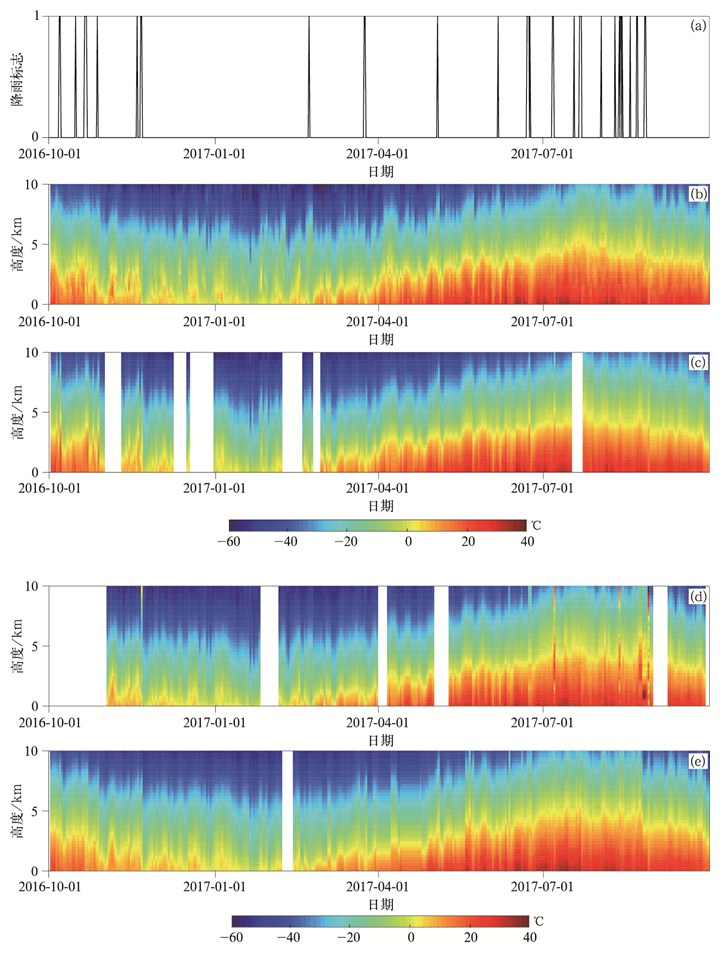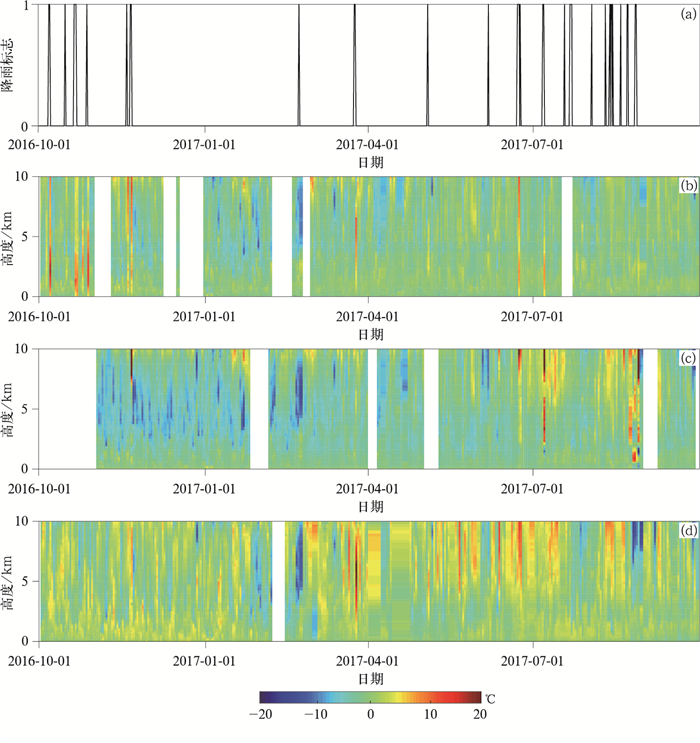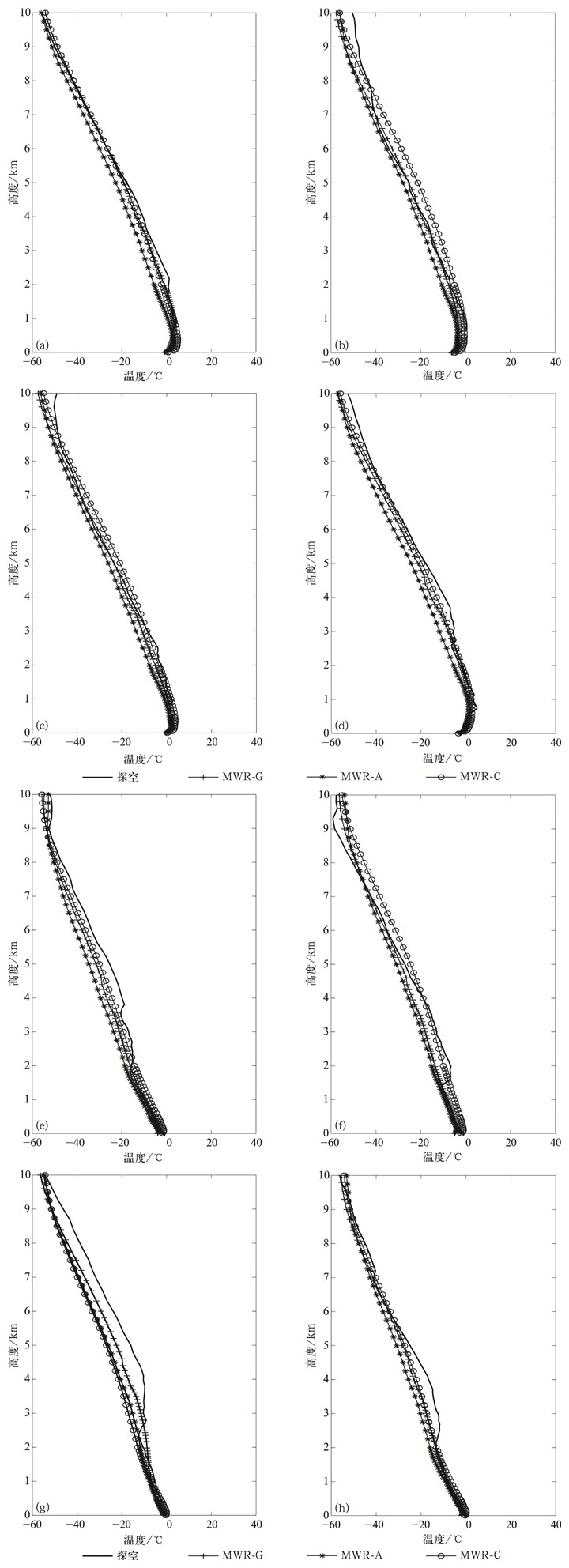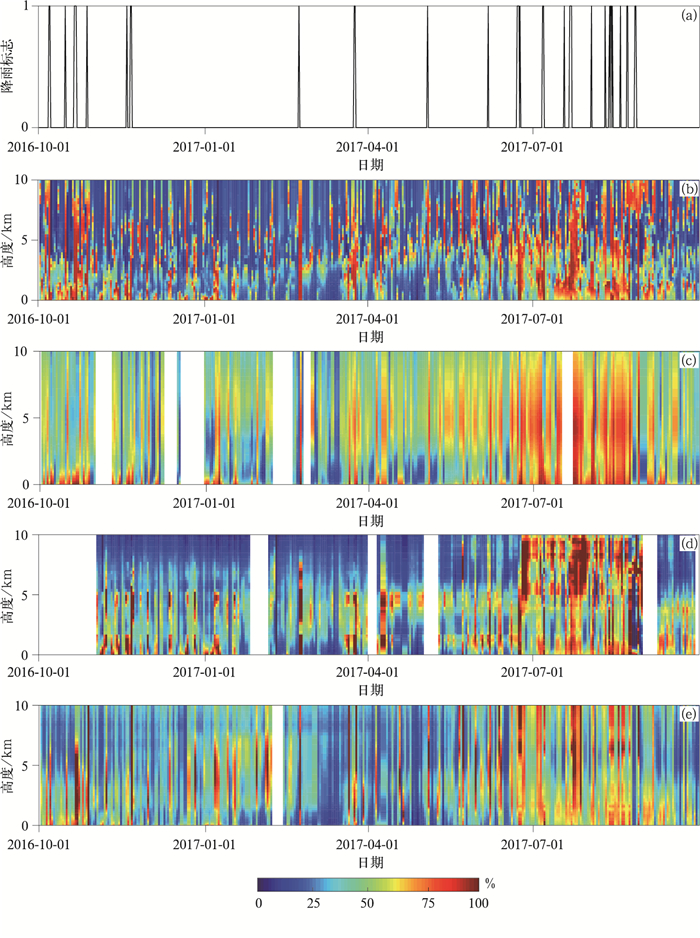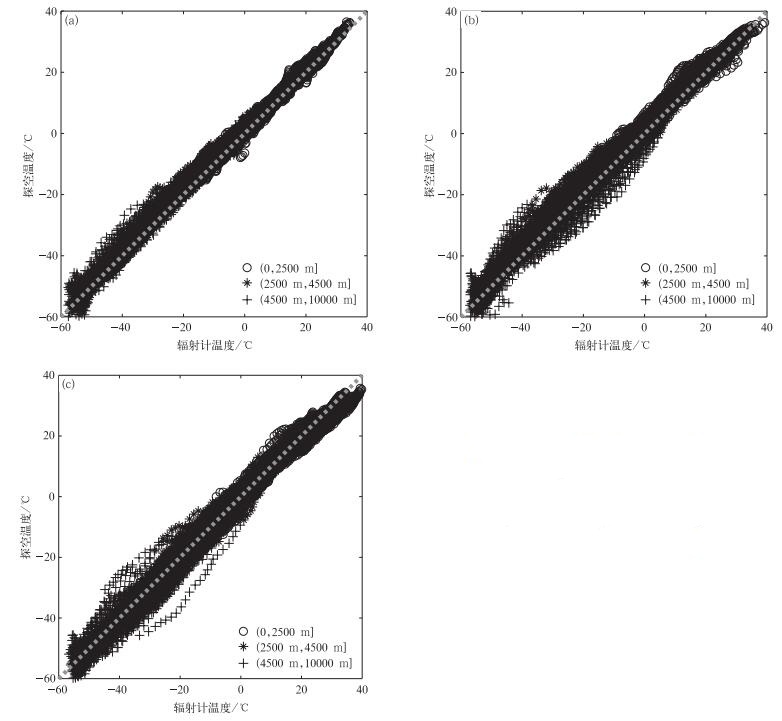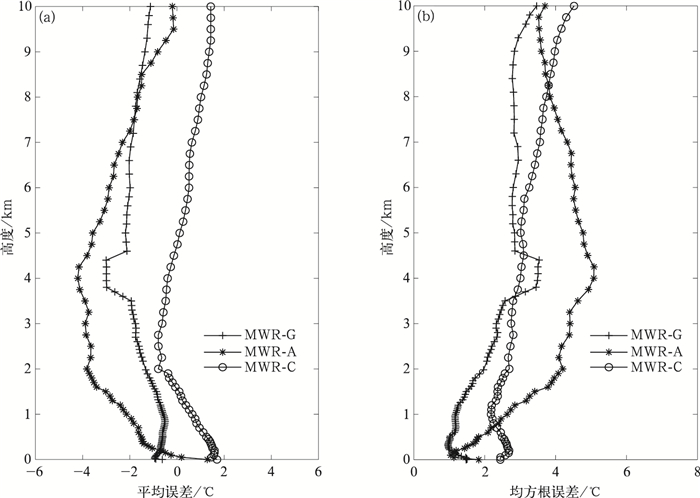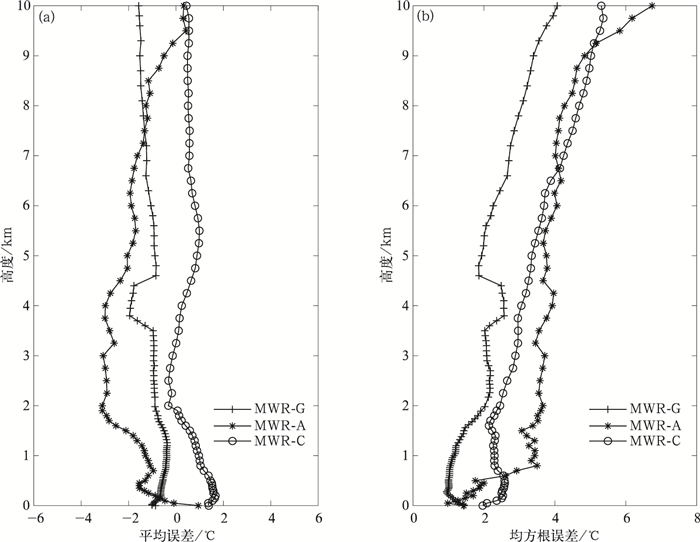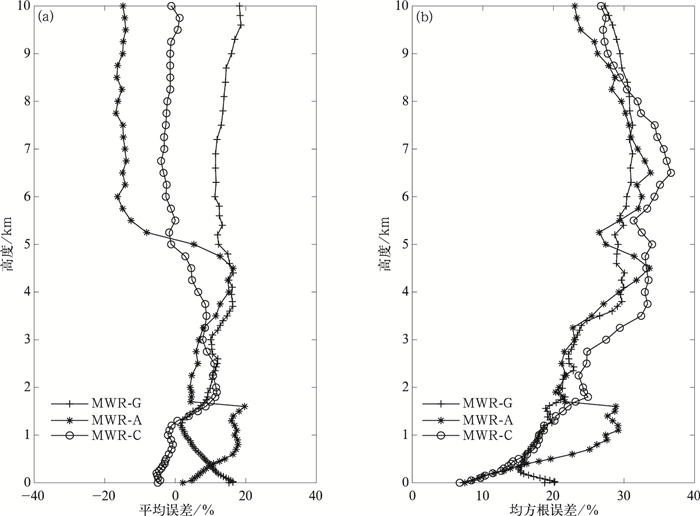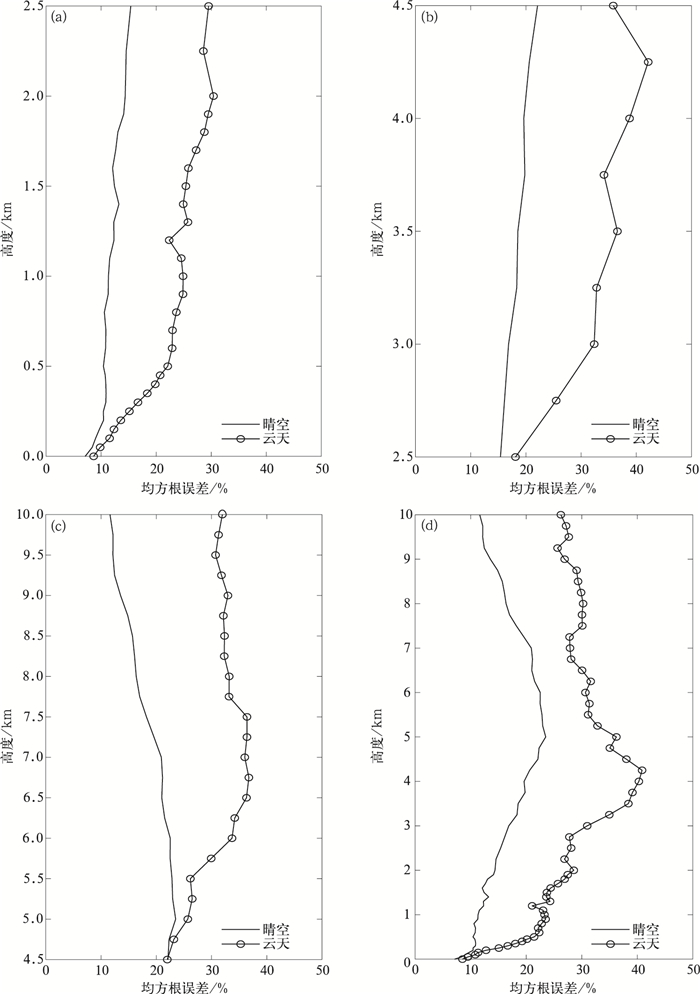Comparison Analysis on Detection Performance of Ground-based Microwave Radiometers Under Different Weather Conditions
-
摘要: 利用探空数据和毫米波云雷达数据,对在大气探测试验基地同址观测的国内外3种型号地基微波辐射计进行1年(2016年10月—2017年9月)的比对分析,重点分析不同型号地基微波辐射计在晴空和云天下温、湿观测性能特征。结果表明:3种型号地基微波辐射计温度与探空相关系数均超过0.98,达到0.01显著性水平;晴空条件下,德国及国产地基微波辐射计温度平均误差均在±1℃以内(前者为负偏差,后者为正偏差),误差较小,美国地基微波辐射计系统偏差约为-1.8℃;3种型号地基微波辐射计均方根误差随高度递增,整体均方根误差以德国地基微波辐射计2.2℃为最小,美国地基微波辐射计3.8℃为最大;在有云条件下,3种型号地基微波辐射计平均误差分布较晴空条件下无明显变化,均方根误差较晴空条件有约增加0.5℃。3种型号地基微波辐射计均呈晴空相对湿度误差小于云天误差,低空误差小于中高空误差的特点;晴空条件下,美国与国产地基微波辐射计相对湿度均方根误差分别为15%和18%左右,小于德国地基微波辐射计;云天条件下3种型号微波辐射计均方根误差均较大(26%左右)。Abstract: Ground-based microwave radiometer (MWR) detects atmospheric temperature and humidity by receiving atmospheric microwave radiation, which can conduct 24-hour unattended, high-resolution observation. It can detect short-time variation of atmospheric elements. MWR is an important supplement to routine sounding. However, it has different observation accuracy at different times, seasons and weather conditions. Observation accuracy and influencing factors analyses are essential in scientific experiments and operation processes.In order to minimize error effects of radiosonde migration, results from three types of remote sensing devices under two weather conditions are compared. By analyzing differences of temperature and relative humidity between sounding and three MWRs at home and abroad of different technology systems in no-cloud and cloud samples, performances of these MWRs are evaluated.In the aspect of temperature, the correlation coefficient for MWRs and sounding is above 0.98. In no-cloud condition, errors of MWR-G and MWR-A are less than ±1℃ (the former is negative and the latter is positive). MWR-A has -1.8℃ deviation. Root mean square errors (RMSEs) of three types of MWRs increase with height. RMSEs of MWR-G, MWR-A and MWR-C are 2.2℃, 3.0℃ and 3.8℃. In cloud condition, vertical distributions of temperature error of three microwave radiometers have no significant changes in comparison with no-cloud condition. The RMSEs of three microwave radiometers in cloud condition are 0.5℃ higher than those in no-cloud condition. Microwave radiometer can identify the near surface radiation inversion layer accurately. But it's hard to identify the high-altitude inversion layer. In the aspect of relative humidity, the error of cloud samples is higher than the error of no-cloud samples, and the error of middle-high cloud samples is higher than that of low cloud samples. In no-cloud condition, RMSEs of MWR-A and MWR-C are 15% and 18%, less than the RMSE of MWR-G. In cloud condition, RMSEs of MWR-G, MWR-A and MWR-C (about 26%) are larger than those in no-cloud condition. The existence of cloud has a major influence on the detection of microwave radiometer relative humidity:No matter which height level, errors of low-middle cloud samples are bigger than those of no-cloud samples. Errors of high cloud samples are bigger than those of no-cloud samples, and the amplification of RMSE is about 10%-20%. This comparison analysis will provide some reference basis for the further improvement of the accuracy of MWR atmospheric profiles and the scientific research, promotion and operation processes of MWRs.
-
Keywords:
- ground-based microwave radiometer /
- error analysis /
- sounding /
- temperature /
- relative humidity
-
引言
地基微波辐射计(以下简称辐射计)通过接收大气微波辐射探测大气温湿廓线,可实现24 h无人值守、高时间分辨率的连续观测,可探测大气要素的短期变化,是对常规业务探空的重要补充,在数值预报、暴雨天气分析、短临预警等方面有重要的应用价值[1-5]。但在不同时段、不同季节、不同天气条件下辐射计的观测精度均有差异[6-10]。天线罩憎水效果、鼓风机运行状态、周围电磁干扰、神经网络算法也会影响到辐射计的观测精度[11-12]。因此,在科学研究和业务化过程中,其在不同天气条件下辐射计的探测性能和影响因素分析必不可少,这对改进设备、完善反演算法、数据应用及设备选型具有重要参考作用。
关于辐射计的性能分析,目前研究集中在以探空为参考标准,对某种型号辐射计分时段、分季节、分天气条件等的比对中。刘建忠等[6]使用探空资料分析了辐射计在不同时段的误差特点。研究表明, TP-WVP3000型辐射计温湿误差20:00(北京时,下同)时段小于08:00时段。刘红燕等[7]利用探空分季节分析了美国Radiometrics公司12通道辐射计大气温度, 3年数据表明:夏季辐射计温度与探空差异最小,冬季最大。侯叶叶等[8]利用探空数据分析了位于北京市观象台的辐射计水汽密度廓线,辐射计与探空水汽密度平均误差冬季较小,夏季较大。另外,张文刚等[9]分析辐射计在不同时段观测精度的同时,对辐射计在不同天气条件下精度情况也进行了分析。以上工作对辐射计精度进行分析,但均集中在单一技术体制、单一型号的设备进行自身探测性能分析,参考标准为探空数据,未结合或很少结合云、雨等新型观测设备数据。目前国内外已经研制出多种型号辐射计,各种技术体制下温度和相对湿度反演效果亦不相同,对于不同技术体制的辐射计在不同天气条件下的比对还较少;另外,云雷达、激光云高仪、全天空成像仪和雨滴谱仪等新型云、雨观测设备的出现,对准确分析不同天气条件对辐射计探测性能的影响提供了较好的资料基础。
为了较全面了解不同型号辐射计探测性能,选取国内外用户较多、性能反映较好的3种型号辐射计,以探空数据为参考,辅以毫米波测云仪、激光云高仪及全天空成像仪等地基遥感设备,在中国气象局大气探测试验基地(北京)开展了为期1年(2016年10月—2017年9月)的试验比对,对其在晴空及云天条件下的温、湿性能进行分析评估,为辐射计设备改进、推广应用、设备选型及业务化提供参考。
1. 数据及评估方法
1.1 试验设备选择及技术指标
参试设备包含2台进口辐射计(分别引进自德国及美国)和1台国产辐射计,为了方便表述,本文将德国产辐射计记为MWR-G,美国产辐射计记为MWR-A,国产辐射计记为MWR-C。
MWR-G使用250 mm抛物面天线,利用光栅网格进行频率分离;接收机使用单边带射频直接检波,本机不产生高频信号;采用并行方式同时探测14个通道的亮温,不同频带亮温资料时间一致且时间分辨率较高,一级亮温数据可达秒级。MWR-A使用全功率接收机,通过依次改变接收机本振频率实现多个频带亮温的测量(变频22通道串行测量),变频后检波辐射计接收通道可复用。该设备由于接收通道较少,接收机体积小,但变频串行测量周期稍长,一级亮温级数据无法达到秒级,通常为分钟级。MWR-C与MWR-A类似,同样使用变频串行22通道测量,一级亮温数据同样为分钟级。3台辐射计探测高度均为10 km,MWR-G将0~10 km分为93层,MWR-A与MWR-C为58层,3台辐射计越靠近地面垂直分辨率越高。
1.2 数据说明及评估方法
1.2.1 试验设备保障及数据来源
辐射计比对试验从2016年10月1日开始,为了保障观测试验数据的可靠性和准确性,根据辐射计探测要求,3台辐射计均已利用与辐射计同址的北京市观象台的历史探空数据进行神经网络训练,试验设备的反演算法均实现本地化。为保障可靠可比性,试验前对3台辐射计进行了液氮标定,标定时进行冷源及热源测试,使误差保证在±1 K以内。试验期间,天线罩定期清洁及更换,鼓风机过滤网及红外镜头定期清洁。其中,3台辐射计从2016年8月—2017年9月均进行了3次液氮标定、2次天线罩更换。
对辐射计进行比对时,选取3台辐射计的温、湿廓线数据和亮温数据,通过检查各台辐射计每日亮温数据,剔除亮温数据异常的样本[12]。探空数据选取与辐射计同址的北京市观象台探空数据。辅助遥感设备数据同样选取与辐射计同址同期的Ka波段云雷达、CL51型激光云高仪、可见光全天空成像仪及地面雨滴谱仪的相关产品资料。
1.2.2 样本分类
本文对试验样本进行严格的探空及地基遥感时空一致性检查,将全部样本分为晴空、云天(包含阴天)两类,以便分析不同技术体制下的辐射计在这两种天气条件下的观测性能。
① 晴空样本:探空、云雷达及激光云高仪在探空对应时段均未观测到云。
② 云天样本:探空入云高度、出云高度与云雷达和云高仪在探空对应时段观测结果相一致(探空相对湿度以85%为阈值判定入云及出云[13-14]),全天空成像仪总云量不小于3成。以地面雨滴谱观测结果为依据,剔除降水样本。
图 1为经过筛选保留下的云天样本个例(2017年7月14日13:15)。从探空湿度廓线可以确定,该时次探空湿度在4800 m左右出现正跳变,4800~6800 m相对湿度为85%~95%。毫米波云雷达基本反射率因子(图 1a)与激光云高仪所测云底高(图 1b)所示云底高均在4800 m附近,云雷达的云厚与探空高湿位置保持一致。查询13:10~13:50全天空成像仪作为验证,可知当时云量为10。经过筛选,确定晴空样本共173组,云天样本共142组。
1.2.3 评估方法
通过对比探空与各辐射计的温湿廓线时序图,分析各辐射计温度和相对湿度的整体表现情况,包括极值、数值变化及不同天气条件、不同高度的表现。通过比对辐射计数据与探空数据,统计两者之间在2种天气条件下的平均误差、均方根误差及相关系数并分析原因[3, 15]。在涉及亮温的分析中,本文以3台设备各通道模拟亮温为参考,模拟亮温通过探空数据经MonoRTM辐射传输模型得出[16]。
2. 辐射计温湿探测性能
2.1 总体评估
2.1.1 温度
将参试的3台辐射计温度产品与探空所有样本绘制成温度廓线时序图(图 2)(空白区为缺测,下同)。由图 2可以看到,3台辐射计温度随时间的变化趋势和在空间上的垂直分布基本与探空保持一致。
为了直观地体现各台辐射计温度较探空差异情况,绘制了辐射计与探空差值廓线时序图(图 3)。由图 3可以看到,MWR-G差值整体小于MWR-A及MWR-C。2017年7月前MWR-A以负偏差为主,进入高水汽量、降水多发的7月和8月转为以正偏差为主。此外,降水发生时辐射计的温度观测会呈现明显偏高的特点,其原因主要是天线罩附着水层对微波信号的影响造成雨天探测失真。
以秋冬季为例,本试验还对探空和3台辐射计的逆温层特征进行比对。图 4为出现逆温层的两类温度样本廓线。由图 4可以看到,在近地面逆温层(图 4a~图 4d)存在以辐射逆温为主的逆温层,辐射计均能较好识别。但在云天或其他天气系统影响下,在更高高度上出现的逆温3台辐射计均很难识别(图 4e~图 4h)。主要原因是辐射计在近地面和低空的廓线信息源于直接探测,而更高高度温度廓线多依靠神经网络模型反演,辐射计在低空的探测精度高于高空,且辐射计在2000 m以下同时利用扫描观测模式可以获得更高精度的温度廓线。
![]() 图 4 逆温出现时辐射计温度廓线(a)2016年12月2日07:00,(b)2016年12月31日07:00,(c)2017年1月2日19:00,(d)2017年1月3日07:00,(e)2017年1月13日07:00,(f)2017年1月15日19:00,(g)2017年2月6日07:00,(h)2017年1月14日19:00Figure 4. Temperature profiles of microwave radiometers in temperature inversion condition(a)0700 BT 2 Dec 2016, (b)0700 BT 31 Dec 2016, (c)1900 BT 2 Jan 2017, (d)0700 BT 3 Jan 2017, (e)0700 BT 13 Jan 2017, (f)1900 BT 15 Jan 2017, (g)0700 BT 6 Feb 2017, (h)1900 BT 14 Jan 2017
图 4 逆温出现时辐射计温度廓线(a)2016年12月2日07:00,(b)2016年12月31日07:00,(c)2017年1月2日19:00,(d)2017年1月3日07:00,(e)2017年1月13日07:00,(f)2017年1月15日19:00,(g)2017年2月6日07:00,(h)2017年1月14日19:00Figure 4. Temperature profiles of microwave radiometers in temperature inversion condition(a)0700 BT 2 Dec 2016, (b)0700 BT 31 Dec 2016, (c)1900 BT 2 Jan 2017, (d)0700 BT 3 Jan 2017, (e)0700 BT 13 Jan 2017, (f)1900 BT 15 Jan 2017, (g)0700 BT 6 Feb 2017, (h)1900 BT 14 Jan 20172.1.2 相对湿度
各辐射计与探空相对湿度廓线时序图(图 5)显示,3台辐射计相对湿度廓线与探空随时间变化趋势较为一致,晴雨识别大体相吻合,但在垂直分布上存在较大的观测误差。其中,秋冬季晴空条件下,0~10 km全部低湿的情况下,各辐射计表现相对一致。有云出现时(图 5b探空地面600 m以上出现高于85%的高湿分层),辐射计湿度同样出现高湿分层,但高湿的位置及厚度各辐射计差异较大,特别是高湿高水汽量的7月和8月,辐射计和探空相对湿度的探测差异增大明显。
2.2 晴空条件
2.2.1 温度
晴空条件下辐射计温度与探空线性拟合情况如图 6所示(虚直线为x=y)。从散点图整体表现看,MWR-G(图 6a)散点分布于直线x=y附近,与探空观测值较吻合,MWR-A(图 6b)及MWR-C(图 6c)散点相对较为离散。此外,MWR-G在(0, 2500 m],(2500 m, 4500 m],(4500 m, 10000 m]高度范围与探空相关系数分别为0.9960,0.9896,0.9882(达到0.01显著性水平),均高于MWR-A及MWR-C。
从晴空条件下辐射计与探空温度廓线误差统计(图 7)可以看到,平均误差方面(图 7a),MWR-G及MWR-A平均误差为整体为负(MWR-G为-0.9℃,MWR-A为-1.8℃),MWR-C平均误差整体为正(0.6℃)。由误差廓线看,MWR-G及MWR-C平均误差均在±2℃以内,MWR-A在1000~7000 m高度平均误差均超过-2℃,误差相对较大。均方根误差(图 7b)方面,MWR-G均方根误差最小(2.2℃),各台辐射计均方根误差整体随高度递增。MWR-A均方根误差(3.8℃)较其他两台辐射计明显偏大,且与平均误差表现类似,误差先随高度递增,到达4000 m高度附近的最大均方根误差(5.2℃)后随高度递减。
2.2.2 相对湿度
晴空条件下,3台辐射计相对湿度与探空有一定的相关性,但相关性明显弱于温度。3台设备在2500 m高度以下相对湿度与探空相关系数分别为0.8213,0.7592,0.7892(达到0.01显著性水平),明显高于(2500 m, 4500 m]及(4500 m, 10000 m]范围;3台辐射计在4500 m高度以上观测值较探空偏大,特别是MWR-G偏大明显,这与刘建忠等[6]研究结果一致。图 8是3台辐射计在晴空条件下相对湿度平均误差及均方根误差廓线。由图 8a可知,3台辐射计平均误差基本上(除MWR-A在9000 m以上及MWR-C在700 m以下高度)呈正偏差,且以MWR-G偏大最为明显,特别在4500 m以上高度,误差为20%~25%。MWR-A和MWR-C平均误差相对较小,绝大多数高度层误差在10%以内。图 8b中,3台辐射计在(0, 2500 m]范围误差小于中高空误差,特别是MWR-G均方根误差在4000 m高度开始由10%迅速增大至33%。MWR-A及MWR-C均方根误差集中于5%~20%。MWR-G水汽和氧气通道亮温均未见异常,其误差较大的原因是在网络模型训练及反演过程中未加入地面高度层的相对湿度信息。此外,MWR-A在0~2000 m高度范围误差廓线“右凸”明显。经过分析,该现象出现源于训练样本不足造成的反演误差。
2.3 云天条件
2.3.1 温度
通过比较云天条件下辐射计温度与探空得到误差廓线(图 9)。辐射计在云天的平均误差廓线特点与晴空条件下基本一致(图 9a),MWR-G误差较小(-1.0℃),为负值;MWR-C误差为1.9℃,为正值;MWR-A误差除1500~4000 m高度外(最大误差为-3.6℃),误差在2℃以内,整体为负值,其结果与晴天条件下相似。3台辐射计均方根误差均随高度递增(图 9b),整体偏差值较晴空增加约0.5℃,增加幅度并不大。MWR-G均方根误差较小(最大均方根误差不超过4.1℃)。
MWR-G在云天及晴空条件下温度观测较探空误差均较小得益于其多通道并行检波技术和硬件设计工艺,保证其快速采样及高精度的亮温获取。以模拟亮温为参考,MWR-A及MWR-C 14个通道实测亮温(表 1)较模拟亮温偏低或偏高的通道数分别达到10个和13个,此外,MWR-A和MWR-C实测亮温较模拟亮温均方根误差较大,这是MWR-A及MWR-C温度观测出现较大偏差的主要原因。
表 1 3台辐射计实测亮温平均误差与均方根误差(单位:K)Table 1. The mean error and root mean square error of three microwave radiometers(unit: K)通道频率/GHz MWR-G MWR-A MWR-C 平均误差 均方根误差 平均误差 均方根误差 平均误差 均方根误差 22.24 0.8574 4.0925 -0.4877 4.0592 2.1631 4.9768 23.04 0.6795 3.7895 -0.2190 3.7839 -0.2361 3.7079 23.84 0.4690 3.2603 -0.9239 3.3203 1.0372 3.0210 25.44 0.2308 2.3124 0.3042 2.3903 2.4818 3.2500 26.24 0.0522 2.1165 -1.4183 2.9852 0.6053 1.8368 27.84 0.0177 1.9188 -1.6491 2.9130 0.7589 1.5521 31.40 0.1240 1.6238 -0.8981 2.1127 0.1778 1.4191 51.26 4.1329 4.5071 4.5629 4.8050 3.3149 4.8146 52.28 2.5576 3.2039 3.6608 3.8599 4.3149 5.3508 53.86 2.7609 3.1892 0.7982 1.7638 3.8261 4.3381 54.94 -0.6435 2.1828 -0.9212 2.3392 0.2680 3.1427 56.66 -1.1438 2.9987 -1.3116 3.1192 0.3860 3.3706 57.30 -1.1575 3.1308 -1.4247 3.2401 0.4923 3.3628 58.00 -1.0578 3.1764 -1.3797 3.3010 0.4982 3.4993 2.3.2 相对湿度
通过绘制3台辐射计在有云条件下的平均误差(图 10a)和均方根误差廓线(图 10b)分析不同型号辐射计在云天条件下的相对湿度性能表现。由图 10a可以看到,3台辐射计误差不超过±20%,总体上4500 m高度以下误差小于4500 m高度以上误差。MWR-G误差较大,且整体偏差为正,MWR-A误差呈两端大(低层和高层)、中间小。MWR-C的误差相比于MWR-G和MWR-A较小。由图 10b可知,3台辐射计均方根误差均较大,整体均方根误差约为26%,MWR-A及MWR-C中高空误差较晴空明显增大。
在微波辐射计相对湿度误差分析中,天气条件是最主要的原因之一。为了深入分析云对辐射计相对湿度观测精度的影响,本试验还将所有云天样本进行分类,分别统计不同样本相对湿度的均方根误差分布。以平均误差较小的MWR-C辐射计为例进行分析。依据云分类标准[17],将云底高度为(0, 2500 m]的划分为低云,(2500 m, 4500 m]为中云,高于4500 m的为高云。筛选得到全部低云样本30个,中云样本8个,高云样本68个。图 11是MWR-C辐射计在有低云、中云及高云条件下相对湿度在相应高度上较探空的均方根误差与晴空条件下的比较情况。结果显示,云所在高度辐射计相对湿度较晴天呈不同程度的增大(最大增幅达20%)。云的出现改变了大气的吸收系数,同时云厚、云高及云中液态水密度均影响云对亮温的作用[18]。由于辐射计配套的红外传感器获得的云信息非常有限,不能给出云的垂直结构及云参量,使反演所需信息不足,造成辐射计反演的相对湿度垂直廓线出现较大偏差[17]。
此外,在有中低云出现的样本中(图 11d),辐射计不仅在中低层高度出现误差增大,高空误差也会增大,增幅约为10%~20%。出现该现象的原因是中低云以冰水混合云或水云为主,空气中含有的大量液态水使微波吸收存在很大不确定性,微波辐射计无法准确捕捉云及云以上高度的微波信息,观测出现较大偏差。高云则不然,高云以冰云为主,冰云微波吸收系数是水云的几百分之一,基本上不吸收微波辐射,冰云对观测亮温基本上没有影响[19]。所以理论上讲,高云出现时,辐射计中低层高度相对湿度的观测误差相比晴空并不会出现明显增加。
3. 结论与讨论
通过探空与地基遥感设备一致性检查进行样本分类,以探空为参考,对3台地基微波辐射计的温湿度廓线产品在晴空及云天条件、不同高度层的误差进行统计,通过1年比对试验得到以下主要结论:
1) 辐射计与探空均具有较好的一致性和相关性。MWR-G及MWR-C晴空温度平均误差不超过±1℃,前者以负偏差为主,后者以正偏差为主,MWR-A偏差较大为-1.8℃。3台辐射计温度均方根误差随高度递增,MWR-G,MWR-A与MWR-C的均方根误差分别为2.2℃,3.0℃和3.8℃。云天条件下,3台辐射计的平均误差廓线与晴空条件下表现相似,均方根误差较晴空增加约0.5℃。
2) 相对于温度,相对湿度的误差整体偏大。辐射计相对湿度多数为正偏差,且呈现在晴天条件下较小,云天条件下较大。晴空条件下MWR-A及MWR-C平均误差在±10%以内,低于MWR-G。MWR-G,MWR-A和MWR-C辐射计均方根误差分别为25%,15%和18%左右。在有云条件下,3台辐射计均方根误差均超过25%,云的存在较大程度上影响到辐射计相对湿度的观测。
微波辐射计温湿探测的准确性受多方面因素影响,硬件工艺、反演算法和天气条件等是影响辐射计探测性能的主要原因。当然,本试验仅从温湿廓线产品的角度对辐射计进行评估分析,由于可比较数据限制,选用L波段探空数据作为参考,虽然辅助地基遥感设备一致性检查尽可能减小气球漂移带来的误差,但其自身的误差和气球偏移误差无法完全消除。因此,本研究所得出的结论尚不全面,还需对辐射计的硬件条件、亮温数据和反演算法进行深入研究,并采用更多的综合比对和验证手段。
-
图 4 逆温出现时辐射计温度廓线
(a)2016年12月2日07:00,(b)2016年12月31日07:00,(c)2017年1月2日19:00,(d)2017年1月3日07:00,(e)2017年1月13日07:00,(f)2017年1月15日19:00,(g)2017年2月6日07:00,(h)2017年1月14日19:00
Figure 4. Temperature profiles of microwave radiometers in temperature inversion condition
(a)0700 BT 2 Dec 2016, (b)0700 BT 31 Dec 2016, (c)1900 BT 2 Jan 2017, (d)0700 BT 3 Jan 2017, (e)0700 BT 13 Jan 2017, (f)1900 BT 15 Jan 2017, (g)0700 BT 6 Feb 2017, (h)1900 BT 14 Jan 2017
表 1 3台辐射计实测亮温平均误差与均方根误差(单位:K)
Table 1 The mean error and root mean square error of three microwave radiometers(unit: K)
通道频率/GHz MWR-G MWR-A MWR-C 平均误差 均方根误差 平均误差 均方根误差 平均误差 均方根误差 22.24 0.8574 4.0925 -0.4877 4.0592 2.1631 4.9768 23.04 0.6795 3.7895 -0.2190 3.7839 -0.2361 3.7079 23.84 0.4690 3.2603 -0.9239 3.3203 1.0372 3.0210 25.44 0.2308 2.3124 0.3042 2.3903 2.4818 3.2500 26.24 0.0522 2.1165 -1.4183 2.9852 0.6053 1.8368 27.84 0.0177 1.9188 -1.6491 2.9130 0.7589 1.5521 31.40 0.1240 1.6238 -0.8981 2.1127 0.1778 1.4191 51.26 4.1329 4.5071 4.5629 4.8050 3.3149 4.8146 52.28 2.5576 3.2039 3.6608 3.8599 4.3149 5.3508 53.86 2.7609 3.1892 0.7982 1.7638 3.8261 4.3381 54.94 -0.6435 2.1828 -0.9212 2.3392 0.2680 3.1427 56.66 -1.1438 2.9987 -1.3116 3.1192 0.3860 3.3706 57.30 -1.1575 3.1308 -1.4247 3.2401 0.4923 3.3628 58.00 -1.0578 3.1764 -1.3797 3.3010 0.4982 3.4993 -
黄治勇, 徐桂荣, 王晓芳, 等.地基微波辐射资料在短时暴雨潜势预报中的应用.应用气象学报, 2013, 24(5):576-584. DOI: 10.11898/1001-7313.20130507 刘思波, 何文英, 刘红燕, 等.地基微波辐射计探测大气边界层高度方法.应用气象学报, 2015, 26(5):626-635. DOI: 10.11898/1001-7313.20150512 鲍艳松, 钱程, 闵锦忠, 等.利用地基微波辐射计资料反演0~10 km大气温湿廓线试验研究.热带气象学报, 2016, 32(2):163-171. http://www.cnki.com.cn/Article/CJFDTOTAL-RDQX201602003.htm 刘红燕, 王迎春, 王京丽, 等.由地基微波辐射计测量得到的北京地区水汽特性的初步分析.大气科学, 2009, 33(2):388-396. http://industry.wanfangdata.com.cn/dl/Detail/Periodical?id=Periodical_daqikx200902016 Han Y, Westwater E R.Remote sensing of tropospheric water vapor and cloud liquid water by integrated ground-based sensors.J Atmos Ocean Technol, 1995, 12(5):1050-1062. DOI: 10.1175/1520-0426(1995)012<1050:RSOTWV>2.0.CO;2
刘建忠, 张蔷.地基微波辐射计反演产品评价.气象科技, 2010, 38(3):325-331. 刘红燕.三年地基微波辐射计观测温度廓线的精度分析.气象学报, 2011, 69(4):719-728. DOI: 10.11676/qxxb2011.063 侯叶叶, 刘红燕, 鲍艳松.地基微波辐射计反演水汽密度廓线精度分析.气象科技, 2016, 44(5):702-709. http://d.old.wanfangdata.com.cn/Periodical/qxkj201605002 张文刚, 徐桂荣, 颜国跑, 等.微波辐射计与探空仪测值对比分析.气象科技, 2014, 42(5):737-741. http://www.doc88.com/p-1425302437426.html 魏重, 雷恒池, 沈志来.地基微波辐射计的雨天探测.应用气象学报, 2001, 12(增刊Ⅰ):65-72. http://www.cnki.com.cn/Article/CJFDTOTAL-YYQX2001S1008.htm 王振会, 李青, 楚艳丽, 等.地基微波辐射计工作环境对K波段亮温观测影响.应用气象学报, 2014, 25(6):711-721. DOI: 10.11898/1001-7313.20140607 傅新姝, 谈建国.地基微波辐射计探测资料质量控制方法.应用气象学报, 2017, 28(2):209-217. DOI: 10.11898/1001-7313.20170208 周玉驰.地基多通道微波辐射计反演大气温湿廓线的研究.北京:中国科学院研究生院, 2010. 唐英杰, 马舒庆, 杨玲, 等.云底高度的地基毫米波云雷达观测及其对比.应用气象学报, 2015, 26(6):680-687. DOI: 10.11898/1001-7313.20150604 姚雯, 马颖, 高丽娜.L波段与59-701探空系统相对湿度对比分析.应用气象学报, 2017, 28(2):218-226. DOI: 10.11898/1001-7313.20170209 黄兴友, 张曦, 冷亮, 等.基于MonoRTM模型的微波辐射计反演方法研究.气象科学, 2013, 33(2):138-145. DOI: 10.3969/2012jms.0127 车云飞, 马舒庆, 杨玲, 等.云对地基微波辐射计反演湿度廓线的影响.应用气象学报, 2015, 26(2):193-202. DOI: 10.11898/1001-7313.20150207 邢业新, 娄国伟, 李兴国, 等.云、雨天气对3 mm波段天空亮温的影响.现代防御技术, 2010, 38(5):82-85. http://www.cnki.com.cn/Article/CJFDTOTAL-XDFJ201005023.htm 白翎, 师春香, 刘冰, 等.CRTM微波亮温模拟对地表和云参数的敏感性分析.气象, 2014, 40(11):1363-1371. DOI: 10.7519/j.issn.1000-0526.2014.11.009 -
期刊类型引用(29)
1. 孙钦宏,马洪波,齐彦斌,于冬佳,樊嘉璐. 长白山麓夏秋季气态和液态水分布特征. 气象与环境学报. 2024(01): 47-53 .  百度学术
百度学术
2. 聂皓浩,王婉,杨洋,林晓萌,郭晓军,李晓波. 华北一次层状云系暖区水汽和液态水分布特征. 应用气象学报. 2024(02): 196-210 .  本站查看
本站查看
3. 胡林宏,姜红林,王皓. ERA5再分析数据在微波辐射计数据反演中的初步应用. 气象科技. 2024(02): 163-172 .  百度学术
百度学术
4. 曹玉杰,闵锦忠,赵新宇. 地基微波辐射计资料的质量控制及同化应用研究. 气象科学. 2024(03): 536-547 .  百度学术
百度学术
5. 李鸾,刘蕾,杨琼琼. 基于微波辐射计的芜湖夏季暴雨特征分析. 气象水文海洋仪器. 2024(04): 14-16+21 .  百度学术
百度学术
6. 张明,徐桂荣,杜裕,叶丹. 三峡地基遥感垂直观测系统温湿廓线的误差分析与订正方法探讨. 暴雨灾害. 2024(05): 587-597 .  百度学术
百度学术
7. 张婷,焦志敏,茆佳佳,张雪芬,王彦霏,陈沛宇,金龙. 微波辐射计联合云雷达的相对湿度校正方法. 应用气象学报. 2024(05): 551-563 .  本站查看
本站查看
8. 王志诚,王伟,励臣儒,周自忠,王晗. 浙江地区不同型号地基微波辐射计基数据质量控制及数据评估. 气象水文海洋仪器. 2024(06): 42-46 .  百度学术
百度学术
9. 寇梦刚,张文煜,毛文茜,孔令彬,程楠. 祁连山水汽、云液态水变化特征分析. 兰州大学学报(自然科学版). 2023(01): 29-35 .  百度学术
百度学术
10. 傅新姝,彭杰,王晓峰,张燕燕,陈哲,吴峻石,薛昊,陈浩君. 地基微波辐射计探测质量综合分析. 气象. 2023(10): 1235-1245 .  百度学术
百度学术
11. 周冰雪,朱朗峰,吴昊,董自鹏,王璇,罗语嫣. 微波辐射计反演大气廓线精度及降水预报应用. 应用气象学报. 2023(06): 717-728 .  本站查看
本站查看
12. 邹倩,陈小敏,邓承之,龙美希. 重庆不同天气条件下地基微波辐射计探测特征. 干旱气象. 2022(01): 114-124 .  百度学术
百度学术
13. 杨杰波,陈柯,徐桂荣,桂良启,郎量,张明洋,金锋,赵若铭,孙春雨. 基于微波辐射计观测亮温数据集的神经网络训练反演研究. 暴雨灾害. 2022(04): 477-487 .  百度学术
百度学术
14. 孙可,孙宝利,杨晓彤,李凝,张旭,魏泽楷. 阜新农业干旱特征与人工增雨应对措施. 江西农业学报. 2022(06): 113-118 .  百度学术
百度学术
15. 梁春旺,贾秋兰,张可嘉,韩翔洋. 国产微波辐射计性能分析. 气象水文海洋仪器. 2022(03): 1-4+8 .  百度学术
百度学术
16. 林晓萌,尉英华,张楠,王艳春. 基于地基遥感设备构建遥感探空廓线. 应用气象学报. 2022(05): 568-580 .  本站查看
本站查看
17. 彭杰,傅新姝,王晓峰. 新型地基遥感观测技术进展和省级业务化应用思考——以上海市气象局为例. 气象科技进展. 2022(05): 74-79 .  百度学术
百度学术
18. 周永水,原野,杨林,王瑾,严小冬. 晴空时微波辐射计温度廓线反演误差分析. 暴雨灾害. 2022(06): 720-726 .  百度学术
百度学术
19. 孙磊,张涛. 成都地基微波辐射计反演大气温湿性能的分析. 西南师范大学学报(自然科学版). 2021(01): 125-132 .  百度学术
百度学术
20. 王志诚,张东明,王聆勤,王明明,王晗,章焕. 杭州地区地基微波辐射计反演水汽特征的比对分析. 浙江气象. 2021(03): 34-39 .  百度学术
百度学术
21. 周永水,原野,万雪丽. 复杂山地环境下雷暴天气中的地基微波辐射计影响距离分析. 热带气象学报. 2020(02): 199-207 .  百度学术
百度学术
22. 张雪芬,王志诚,茆佳佳,汪章维,张东明,陶法. 微波辐射计温湿廓线反演方法改进试验. 应用气象学报. 2020(04): 385-396 .  本站查看
本站查看
23. 徐爽,李芷霞,陈兴鹃,施海瑞,刘立辉. 国产MWP967KV型微波辐射计性能分析. 国外电子测量技术. 2020(08): 22-28 .  百度学术
百度学术
24. 许皓琳,郑佳锋,姜涛,黎倩,曾正茂,张杰,朱克云. 乌鲁木齐和成都两地机场雷暴降水水汽条件的分析研究. 气象. 2020(11): 1440-1449 .  百度学术
百度学术
25. 翟晴飞,张晋广,王斌飞,袁健,李遥,李鸣钰. 微波辐射计反演大气温湿度廓线与降水相关性分析. 气象与环境学报. 2020(06): 98-107 .  百度学术
百度学术
26. 乔贺,徐进,刘寅,周晨. 地基微波辐射计温湿廓线对比试验初步分析研究. 环境科学与管理. 2019(10): 129-134 .  百度学术
百度学术
27. 刘晓璐,刘东升,郭丽君,雷连发,冯金燕. 国产MWP967KV型地基微波辐射计探测精度. 应用气象学报. 2019(06): 731-744 .  本站查看
本站查看
28. 陈彦霖,董浩. 微波辐射发生器ACNS核心电路结构设计及性能测试. 电子测量技术. 2019(20): 110-113 .  百度学术
百度学术
29. 茆佳佳,张雪芬,王志诚,杨荣康,潘旭光,季承荔,郭然. 多型号地基微波辐射计亮温准确性比对. 应用气象学报. 2018(06): 724-736 .  本站查看
本站查看
其他类型引用(5)

 设为首页
设为首页 加入收藏
加入收藏



 下载:
下载:
